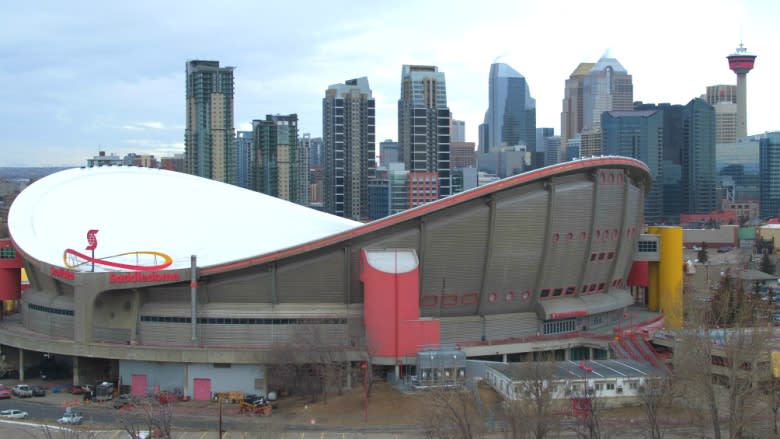What happens when the Calgary Flames leave the Saddledome

Imagining what might happen to the Saddledome when the Calgary Flames are no longer the primary tenant is the basis of a new report.
The document, titled Calgary Saddledome Potential Future Uses Study, was obtained by the Canadian Taxpayers Federation (CTF) through a Freedom of Information request.
City council is expected to review the report in the new year.
Commissioned by the Calgary Saddledome Foundation — which was formed in the 1980s to operate the facility — the report lists four main possibilities for what happens after the Flames leave:
- Continue operating the 'Dome without a major tenant.
- Repurpose it into a recreation centre, convention centre, multi-use facility or Olympic venue.
- Decommission it.
- Demolish it.
Transforming the Saddledome into a recreation centre could turn a profit, while the other options are anticipated to be money losers for the city, to the tune of roughly $1 million or more per year.
The city and Calgary Sports and Entertainment Corporation — which owns the Calgary Flames, Stampeders, Hitmen and Roughnecks — have been at odds over the construction of a new arena for several months.
CSEC president Ken King said in September they will no longer be pursuing a deal for a new arena, citing a lack of progress.
The two sides last met in July and King described the negotiating process thus far as "spectacularly unproductive."
Mayor Naheed Nenshi has said the city remains open to continuing talks.
The team had earlier proposed what it called CalgaryNEXT, an $890 million stadium, fieldhouse and convention centre in the downtown west end, which would be funded through a mix of public and private dollars.
Those plans were later abandoned and the two sides began discussing what the city referred to as Plan B in the community of Victoria Park, west of Fifth Street between 12th and 14th avenues S.E.
The report notes that 17 other cities — four in Canada and 13 in the United States — have replaced NHL facilities with new buildings. Of those, 11 cities demolished the old arenas and six kept them, but three were later torn down.
Only in Montreal, Toronto and Los Angeles do the old rinks remain as repurposed spaces.
Completed in 1983, the Saddledome was built for the 1988 Winter Olympics.
Continue operating without a major tenant
The report notes just one positive aspect of continuing to operate with an anchor tenant — that it will remain open for use.
The biggest drawback would be the cost to the city, which the report estimates to be between $1 million and $1.4 million per year. As well, it notes the team will likely have moved to a similar, 20,000-seat venue in the same market, which would be "a significant source of competition."
Repurpose
There are four options listed for repurposing the Saddledome — turning it into a recreation centre, turning it into a convention centre, turning it into a 6,000-seat multi-use facility, or using it for the 2026 Olympics.
Costs and timelines for those option break down as follows:
Recreation centre with six ice arenas or three ice arenas and three soccer pitches:
- Cost to repurpose: $138 million to $165 million.
- Design timeline: 12 months.
- Construction timeline: 40 to 44 months.
- Operating cost: City would profit $1.7 million to $2.3 million per year.
Convention centre:
- Cost to repurpose: $130 to $156 million.
- Design timeline: 12 months.
- Construction timeline: 40 to 44 months.
- Operating cost: City would lose $1.5 million to $2 million a year.
A 6,000 seat multi-use area:
- Cost to repurpose: $44 million to $53 million.
- Design timeline: 12 months.
- Construction timeline: 22 to 26 months.
- Operating costs: City would lose $900,000 to $1.2 million per year.
2026 Olympic venue:
- Cost to repurpose: $28 million to $34 million.
- Design timeline: 12 months.
- Construction timeline: 8 to 12 months.
- Operating cost: Would be a one-time event, then decision needed whether to repurpose or demolish.
Decommission
The third option is to decommission the Saddledome and make it available for use during specific events, like the Stampede, or the 2026 Olympics.
The cost for that — providing things like security and keeping the pipes from freezing — is expected to be in the range of $600,000 to $800,000 per year.
The report also notes this option could work as a stopgap measure of sorts until a decision is made about repurposing the building.
Demolition
The cost of demolishing the Saddledome is estimated to run between $11 million and $13 million.
One drawback to tearing the 'Dome down, the report notes, will be "the emotional loss of a revered building and prominent icon in Calgary's skyline."
- MORE CALGARY NEWS | Understanding, compassion and knowledge: U of C unveils Indigenous strategy
- MORE CALGARY NEWS | Douglas Fir Trail in Calgary's inner city reopens after 4 years

 Yahoo Sports
Yahoo Sports 